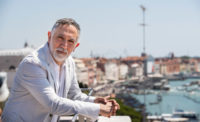Chicago just got a little colder as the end to a decades-long building boom has left two of the city’s tallest building projects stuck in limbo, leaving their owners scrambling to seek alternative methods of financing. Developers of the 1,047-ft-tall Waterview Tower and 2,000-ft-tall Chicago Spire bet that enough sales would come through before the market turned sour, but they lost that round—at least for now. Construction of the two supertall residential projects may be on hold until the market rebounds, but industry observers believe the buildings will not be left out in the cold forever.



In both cases, speculators may have bitten off more than they could chew. “Ninety-five percent of the developers in this market first obtain the construction loan, and then they put a shovel in the ground,” says Gail L. Lissner, vice president of local real-estate analyst Appraisal Research Counselors. “These are the two exceptions.”
Waterview, owned, designed and built by Chicago-based Teng & Associates Inc., is slated to contain an upscale Shangri-La hotel and luxury condos. When complete, it will be the fifth-tallest building in the city at 89 floors. But today its concrete shell on West Wacker Drive stands quietly at about the 25th floor, on hold again this year despite an original completion date of 2009. A Teng project official to whom ENR was referred did not return phone calls. This past spring, work on Waterview was placed on hold but resumed construction after the owner reportedly obtained funding from an overseas source.
Then there’s the Spire, designed by Zurich-based architect-engineer Santiago Calatrava, who envisions the tallest building in the Western Hemisphere soaring to 150 stories above the mouth of the Chicago River. But at the moment it is nothing more than a gaping hole in the ground. The building already is on its second developer, Dublin-based Shelbourne Development’s Garrett Kelleher, who has embarked on a world tour to drum up luxury condo sales as well as nontraditional sources of funding for the ambitious project, whose completion has now been pushed back to 2012. Its original due date was 2010.
Amid such economic uncertainty, Calatrava and architect-of-record Perkins + Will have taken out liens totaling more than $16 million for what they claim are unpaid design fees. Shelbourne officials counter such measures are expected in hard economic times. “The market is the 800-lb gorilla in the room,” says Kim Metcalfe, the project’s spokeswoman. “We need banks to start acting like banks. It’s completely seized up.”
Still, the owner reports that sales for the twisting tower are brisk. “We are over 30% sold, not including the penthouse,” says Metcalfe. In an attempt to boost investor confidence, the owner announced on Oct. 3 that Beanie Baby billionaire Ty Warner snatched the top residence for an undisclosed sum. It was listed for $40 million. The slender yet tall building, which would hold 1,194 units, is a tough exercise in height as well as volume. “That’s the size of four large high-rises in Chicago,” says Lissner. “It’s a tremendously challenging project.”
When construction will resume on Spire is anyone’s guess. Shelbourne says it will start working on the superstructure when the market stabilizes and still is in talks with a general contractor to build it. Foundations for the building and its eight-story, underground parking garage are done. “We’re not quite paid off, but we’ve got personal guarantees from Kelleher,” says Robert E. Schock, vice president of caisson contractor Case Foundation Co. “It’s just a difficult time for developers to get money for loans.”
Meanwhile, Donald Trump’s 1,362-ft-tall hotel and condominium tower, started in 2003, is approaching the finish, having topped out in late September. “The advantage we have is that our building is built, whereas the other buildings that haven’t been built, they aren’t going to happen,” Trump says. Though Trump’s timing was obviously good, Lissner says it wasn’t perfect, noting the building is 25% vacant.
The 92-story Trump International Hotel and Tower, designed by Skidmore Owings & Merrill LLP and built by Bovis Lend Lease, is due to wrap up next spring. It is set to become the second-tallest building in Chicago and the tallest completed in the U.S. since Sears Tower in 1974.
It may mark the end of an era. This year and next, Chicago will see record deliveries of condos and rentals, about 7,000 total each year, says ARC. By the end of the decade, overall housing in downtown Chicago could increase as much as 129%, from 48,000 units in 1990 to 110,000 in 2010. This year’s deliveries are about 75% under contract and next year’s are 60% sold. “The flip side is 25% this year and 40% next year,” says Lissner. “They still have their challenges, and the meter is ticking.”
As such, the future for more-aspiring projects like Spire remains uncertain. They promise to attract a wealthy, international audience. Yet taxpayer-funded bailouts of financial firms may undermine badly needed construction loans, Trump says. “The banks will be so busy paying back the federal government, they won’t have time for buildings like this,” he says. The typical sales ratio to ink a deal is 50%, but lenders now are more picky. “We are in uncharted waters,” Metcalfe says. “But clearly, we are going to be in a really, really good place when the market turns around.”
Despite the cold snap, some think Spire will thaw out soon enough. “Construction might be delayed for awhile, but I don’t see the project dying,”Schock says. “There is too much momentum.”



